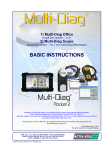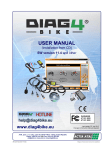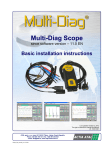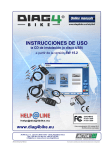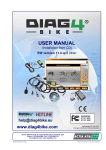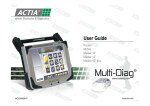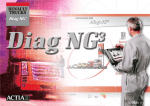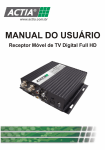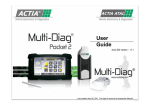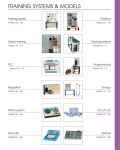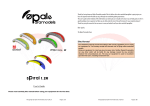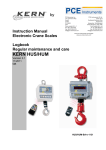Download Open manual
Transcript
INSTRUCTIONS FOR USE SMART POWER BENCH 2 www.diag4bike.eu Last update: 11. June 2015 Changes to this document reserved (text and photos) ACTIA CZ s.r.o., Lesní 47, 390 01 Tábor - Horky, Czech Republic Phone: +420 381 410 100; Fax: +420 381 253 043 [email protected]; www.actia.cz; www.diag4bike.cz user-manual-spb-2-en.docx 14.5.2007 změna návodu vyhrazena All trademarks and all copyrights are recognised No authorisations or approvals by motorcycle manufacturers are automatically implied Instructions for Use of the Smart Power Bench 2 CONTENTS 1. 2. 3. 4. 4.1.1 5. 6. 7. 8. 8.1 8.2 8.3 8.4 9. 10. 10.1 11. 11.1 11.2 11.3 11.4 12. 12.1 12.2 12.3 12.4 INTRODUCTION ..................................................................................................................................................... 3 INSTALLING STATION – LOCATION ..................................................................................................................... 3 INSTALLING THE BIKE AT THE STATION ............................................................................................................ 3 MEASURING THE ENGINE POWER PARAMETERS ............................................................................................ 4 NOTES ON THE MEASUREMENT PROCEDURE: ................................................................................................ 6 SPECIFICATIONS:.................................................................................................................................................. 6 SAFETY PRECAUTIONS ........................................................................................................................................7 ELECTRONIC CONTROL UNIT SPB – AT531 4188 .............................................................................................. 8 MAINTENANCE ...................................................................................................................................................... 9 GREASING OF THE CHAIN WITH SPRAY LUBRICANTS .................................................................................... 9 CHECKING THE CHAIN TENSION ...................................................................................................................... 10 BEARING LUBRICATION IS PERFORMED THROUGH A GREASE NIPPLE ..................................................... 10 VISUAL INSPECTION OF THE MECHANICAL AND ELECTRICAL PARTS ........................................................ 10 SPARE PARTS LIST ............................................................................................................................................. 10 TROUBLESHOOTING .......................................................................................................................................... 10 CUSTOMER SUPPOR .......................................................................................................................................... 10 STANDARD ACCESSORIES ................................................................................................................................ 10 MEASURING ENGINE TEMPERATURE - AT132 4012 ....................................................................................... 10 MEASURING INTAKE AIR TEMPERATURE - AT132 4017 ................................................................................. 11 MEASURING TIRE TEMPERATURE - AT157 4013 ............................................................................................. 11 WIRELES REMOTE CONTROLLER - AT157 4006 .............................................................................................. 11 OPTION................................................................................................................................................................. 11 ADDITIONAL MOTORCYCLE COOLING - AT131 4002....................................................................................... 11 EXHAUST GAS EXTRACTOR - AT131 4001 ....................................................................................................... 11 THROTTLE CONTROL LIMITER - AT531 4097 ................................................................................................... 12 INSTALLATION SET LAMBDA - AT106 4020 ....................................................................................................... 12 user-manual-spb-2-eu-en.docx —2— All trademarks and all copyrights are recognised. No authorisations or approvals by motorcycle manufacturers are automatically implied. Instructions for Use of the Smart Power Bench 2 1. INTRODUCTION The following text describes basic procedures for installing the station, mounting a bike at the station, and also measurement of power related parameters. The station can also be used for diagnostics of motorbikes under operating conditions. Load characteristics of the station in load gear 1 simulates the load on the motorbike on the road. The mass roller simulates the weight of the motorcycle and driver. The built-in fan simulates aerodynamic losses. In addition, the station can be used for the tuning of engines. In the first step, the basis of professional engine tuning is measuring of the engine's VE maps (of each engine cylinder) under load. To do this, both load gears of the station are used. The second load gear is used for low speed modes. The Instructions for Use include a demonstration video. 2. INSTALLING STATION – LOCATION The station must be installed on a level and stable surface so as to rule out any contact of the roller with the surface under the station. Location of the stations must conform to generally applicable regulations for engine testing stations. The station is designed for indoor use and must be especially protected against the rain. During the measuring procedure, reliable extraction of the bike's exhaust gas must be provided. The station requires power supply of 230V AC (use of adaptor necessary), or 12V DC, with the power input of 24 W. (Power supply can therefore be provided even from a 12V vehicle battery) The operating temperature range of the station is +10 to +40 °C. 3. INSTALLING THE BIKE AT THE STATION Using a strap (see Fig. 1), fix the front wheel securely to the adjustable part of the SPB frame which must be secured with the securing pin. The axis of the rear wheel must be moved forward from the roller axis by 20-30 mm (see Fig. 2). Fig. 1 Fig. 2 user-manual-spb-2-eu-en.docx —3— All trademarks and all copyrights are recognised. No authorisations or approvals by motorcycle manufacturers are automatically implied. Instructions for Use of the Smart Power Bench 2 In the rear part, fix the bike securely to the SPB using one strap to one of the side SPB holes, symmetrically at both sides of the station. The bike must be securely fixed, preferably on the load-bearing frame, in an upright position. Tighten the securing strap so that it simulates the operating load and prevents slippage of the rear wheel on the roller. Make sure the straps do not touch or near the exhaust pipe. For a strap, use exclusively a certified strap, with no modifications, rated for a load of 1000 Kg Any loose ends should be fixed to the straps. The rear tyre of the bike should be inflated to the maximum allowable pressure specified by the tyre manufacturer. Large part of the bike cooling is provided by the integrated fan via the connected hoses. Adjust these hoses so they provide cooling of the engine as well as the exhaust, mainly at the part of the engine connection. Notes on installation of the motorbike at the SPB: For long-term testing (measuring VE maps), we recommend a use of an additional cooling fan 4. MEASURING THE ENGINE POWER PARAMETERS The results of the measurements are power and torque characteristics depending on the engine speed related to (converted) the crankshaft of the engine. The results are standardised to the existing ambient conditions (temperature of the induced air and barometric pressure). The reference point is represented by a temperature user-manual-spb-2-eu-en.docx —4— All trademarks and all copyrights are recognised. No authorisations or approvals by motorcycle manufacturers are automatically implied. Instructions for Use of the Smart Power Bench 2 of 20 °C and barometric pressure of 100 kPa. These values can be changed in the program settings and they are listed in each measurement result printout. Station Measurement of power characteristics is carried out only at load gear 1 of the SPB Before measuring power parameters, it is necessary to heat the rear tire by a running test up to the temperature recommended by the manufacturer of the tire (the temperature should be within the range 50 – 70°C) 4.1 MEASUREMENT PROCEDURE Start the DIAG4POWER program (see Fig. 3) Enter the name of the measurement, and notes on the measurement, if an (see Fig. 4) Fig. 3 Fig. 4 Set the default measurement conditions (see Fig. 5): o Maximum engine speed required for the measurement. This speed should be set at least 200 min-1 below the maximum permitted engine speed. o Ambient temperature (default 20˚C) o Reference atmospheric pressure (default 100 kPa) Click the „NEXT button to start the measurement (see Fig. 5) Fig. 5 Fig. 6 Start running the bike in an appropriate (1) gear and keep the engine speed to a minimum, but still in the smooth running of the engine. To start the measurement: o press the START button in the program (see Fig. 5) or o press the ENTER button on the wireless remote control (AT157 - Fig. 6) The program starts by counting down (see Fig. 7), followed by the GO command (see Fig. 8) user-manual-spb-2-eu-en.docx —5— All trademarks and all copyrights are recognised. No authorisations or approvals by motorcycle manufacturers are automatically implied. Instructions for Use of the Smart Power Bench 2 Upon the GO command, it is necessary to quickly set the throttle (2) to fully open (by turning the grip accelerator to full position). In this measurement phase, the engine accelerates and on reaching top measuring speed the program displays the STOP sign (see Fig. 9) Immediately after STOP is displayed, the operator must simultaneously disengage the clutch of the engine and close the throttle to the idle position (accelerator to minimum). It is necessary to remain in this status until the end of the deceleration measurement when processing of the measured data is displayed. This is followed by a display of speed characteristics of torque and power with parameters of the maximum engine power achieved in kW and the rotational torque in Nm (see Fig. 10). Fig. 7 Fig. 8 Fig. 9 Fig. 10 4.1.1 NOTES ON THE MEASUREMENT PROCEDURE: (1) A choice of an appropriate gear is done before the actual measurement through an acceleration test. Start the test by a slow acceleration in the top gear. If you can achieve the maximum permissible speed, then this is the most appropriate gear for performing the measurement. If you fail to achieve it, downshift one gear and repeat the test until you reach the maximum speed. If you find any nonstandard signs of the engine or the bike construction that indicate excessive wear or fault of the bike, discontinue the test immediately. The test should not be resumed until the fault is corrected. (2) The above procedure describes measurement of external power parameters of the engine (measured at 100% throttle opening). Measurement of power characteristics for different throttle opening is performed using the Throttle Control Limiter. This yields parametric performance parameters. (3) For the Harley - Davidson engines, it is the speed range from 1500 to 2000 min-1 5. SPECIFICATIONS: Weight: 550 kg Dimensions: 2,8m x 0,5m x 1m (w x d x l), 110" x 20" x 40" Roller diameter: 450 mm, 18" o Mass moment of inertia of the system: ~12 kgm2 (see label on SPB) – Gear 1 Measurement range of engine power: 10 – 250 kW At load, power input of the fan is mainly given by the built-in load fan, and is dependent on the engaged gear of the station (the following data is for illustration only): Gear 1: o 10 kW at 100 km/h (60 MPH) o 30 kW at 150 km/h (90 MPH) o 70 kW at 200 km/h (120 MPH) Gear 2: o 10 kW at 50 km/h (30 MPH) o 30 kW at 75 km/h (45 MPH) o 70 kW at 100 km/h (60 MPH) Maximum driving speed (peripheral speed of the roller): o Gear 1: 250 km/h, 150 MPH o Gear 2: 100 km/h, 63 MPH Connection to PC: RS 232 or USB user-manual-spb-2-eu-en.docx —6— All trademarks and all copyrights are recognised. No authorisations or approvals by motorcycle manufacturers are automatically implied. Instructions for Use of the Smart Power Bench 2 Required PC operation system: XP, W7, W8 Power supply of the station: 230V AC or 12V DC with power of 24 W. Power supply can therefore be provided from a 12V vehicle battery. The operating temperature range of the station: +10 to +40 °C. Cooling of rear tire: provided automatically by the built-in fan Temperature measurement of the rear tire: IR measurement Remote control: IR (infra red) Measuring ambient air pressure: 870 to 1100 hPa (at sea level) 6. SAFETY PRECAUTIONS These safety precautions must be posted near the Smart Power Bench station. The station may only be operated by a trained person. During the measurement, the operator must protect their eyes and ears and wear tight-fitting work clothing and safety boots. During the operation, the station must be in perfect condition and must be connected to the power supply of 230V/12V, 24W. Before starting the measurements, always make sure that the measured bike is in perfect condition and is securely attached to the station. In the rear part, fix the bike securely to the SPB using one strap to the side SPB holes. The bike should be securely fixed, preferably on the load-bearing frame, in an upright position. Tighten the securing strap so that it simulates the operating load and prevents slippage of the rear wheel on the roller. Make sure the straps do not touch or near the exhaust pipe. Any loose ends should be fixed to the straps. During the acceleration measurement, there should be no tire slippage by using inappropriate (too low) gear. The rear tyre of the bike should be inflated to the maximum allowable pressure specified by the tyre manufacturer. During the measurement, there should be no other person within a radius of two meters from the station and 10 meters behind the station, except for the engineer performing the measurement. During the measurement, within a radius of 4 meters the station should be free from objects that might be sucked into the air inlet hole of the station. The maximum allowable speed of the station may not be exceeded during the measurement: o 250 Km/h in gear I o 100 Km/h in gear II Exceeding the specified speed is indicated by the red light on the safety set of traffic lights placed in front of the station and always in the operator's field of vision. The Orange light indicates a level exceeding 90 % of the maximum speed. Green light indicates the operating status with the built-in fan rotating Blinking green light indicates a rotating fan within the permitted speed. In this status it is possible to change load gears of the station (I - II) During the measurement, it is necessary to provide proper extraction of exhaust gases outside the measurement area. Measurements must not be started if the green light of the traffic lights is not on (or flashing). user-manual-spb-2-eu-en.docx —7— All trademarks and all copyrights are recognised. No authorisations or approvals by motorcycle manufacturers are automatically implied. Instructions for Use of the Smart Power Bench 2 During the measurement, the temperature of the tire should be checked, and if the tire temperature exceeds the maximum allowable temperature of the manufacturer, the measurement must be discontinued immediately. The maximum allowable speed of rear tire may not be exceeded during the measurement. During the measurement, maximum design speed and RPM of the bike engine may not be exceeded. On the station, gears may only be changed if the green light on the safety traffic lights is flashing. Flashing green light indicates that the fan has stopped. Stopping of the roller does mean stopping of the fan! 7. ELECTRONIC CONTROL UNIT SPB – AT531 4188 Fig. 11 user-manual-spb-2-eu-en.docx —8— All trademarks and all copyrights are recognised. No authorisations or approvals by motorcycle manufacturers are automatically implied. Instructions for Use of the Smart Power Bench 2 Fig. 12 1 ............Control of the motorcycle engine cooling fan 2 ............Redundant 3 ............Redundant 4 ............Inductive sensor of the SPB fan speed (loading) 5 ............Cylinder speed sensor 6 ............Ignition sensor of the motorcycle engine speed 7 ............Thermometer measuring the intake air temperature - not fitted yet 8 ............Thermometer measuring the motorcycle rear tyre surface temperature (IR thermometer = Infra Red) 9 ............"ON" indicator 10 ..........Communication between RS232 and PC 11 ..........Supply voltage:12V DC 12 ..........Thermometer measuring the motorcycle engine temperature (IR thermometer) - not fitted yet 13 ..........Redundant 14 ..........Set of traffic lights indicating exceeded speed of the loading fan (maximum permitted speed exceeded) 8. MAINTENANCE Maintenance and cleaning of the station, as well as removing or lifting the protective equipment, may only be performed with the rotating parts of the station stopped. 8.1 GREASING OF THE CHAIN WITH SPRAY LUBRICANTS We recommend that only high quality, certified lubricants for sealed chains should be used The application is done by spraying the chain. After greasing, it is necessary to leave the chain at rest for about 15 min in order to let the solvents evaporate to prevent any squirt-off of the lubricant. user-manual-spb-2-eu-en.docx —9— All trademarks and all copyrights are recognised. No authorisations or approvals by motorcycle manufacturers are automatically implied. Instructions for Use of the Smart Power Bench 2 The chain re-greasing is recommended every 5 hours of the station operation. 8.2 CHECKING THE CHAIN TENSION Performed after 20 hours of the station operation. The slack of the lower part of the chain in the middle must be within the range of 5-10 mm. 8.3 BEARING LUBRICATION IS PERFORMED THROUGH A GREASE NIPPLE Performed every 200 hours of the station operation Lubricant type - plastic industrial grease NLGI 2-3,ISO 6743/9 CCEB2/3,DIN 51 502 KP2/3K-30. 8.4 VISUAL INSPECTION OF THE MECHANICAL AND ELECTRICAL PARTS Before each measurement. 9. SPARE PARTS LIST Chains Gears Straps 10. TROUBLESHOOTING 10.1 CUSTOMER SUPPOR Customer support contact (servicing) ACTIA CZ s.r.o. Lesní 47, 390 01 Tábor – Horky Czech Republic Phone: +420 381 410 100 Fax.: +420 381 253 043 e-mail: [email protected] web: www.diag4bike.eu 11. STANDARD ACCESSORIES 11.1 MEASURING ENGINE TEMPERATURE - AT132 4012 0°C to 200°C Contactless infrared thermometer user-manual-spb-2-eu-en.docx — 10 — All trademarks and all copyrights are recognised. No authorisations or approvals by motorcycle manufacturers are automatically implied. Instructions for Use of the Smart Power Bench 2 11.2 MEASURING INTAKE AIR TEMPERATURE - AT132 4017 -9°C to 70°C 11.3 MEASURING TIRE TEMPERATURE - AT157 4013 0°C to 200°C Contactless infrared thermometer 11.4 WIRELES REMOTE CONTROLLER - AT157 4006 Infrared 12. OPTION 12.1 ADDITIONAL MOTORCYCLE COOLING - AT131 4002 This powerful Axial Fan is useful equipment for additional engine cooling while using the Smart Power Bench. The fan is equipped with two power levels. Power levels are switchable between level 1, level 2 and auto. The Auto level is dedicated for Tuning Measurements (VE maps measurement). The Smart Power Bench automatically controls the power level of the fan dependent on engine temperature. Level 1 - Electric Power 0.5 kW, Airflow 4 700 m3/h, Air speed 26 km/h Level 2 - Electric Power 2 kW, Airflow 11 000 m3/h, Air speed 60 km/h 12.2 EXHAUST GAS EXTRACTOR - AT131 4001 This powerful Radial Fan is designed for extraction of exhaust gases from motorcycles during power tests and during tuning measurements. The fan is equipped with adapters for one side and two side motorcycle exhaust pipe configurations. The fan output is connected to the hose diameter of 305 mm with a length of 3 m. Electric power 3 kW, Airflow 6000 m3/h. a) One side exhaust pipe – diameter 250 mm user-manual-spb-2-eu-en.docx — 11 — All trademarks and all copyrights are recognised. No authorisations or approvals by motorcycle manufacturers are automatically implied. Instructions for Use of the Smart Power Bench 2 b) Duo sides exhaust pipe – diameter 2x200 mm c) Yoke 12.3 Throttle control limiter - AT531 4097 Throttle control limiter is useful option for VE maps measuring. This tool helps in setting of constant throttle position during acceleration or deceleration. 12.4 INSTALLATION SET LAMBDA - AT106 4020 This set allows you to install two broadband lambda probes on any exhaust ! 1. Fitting for lambda probe in the exhaust is M18 x 1,5 1.1. Direct Installation (enough place for Wide Band lambda probe installation) 1.2. Radial Installation (not enough place for Wide Band lambda probe installation) 1.3. Tangential Installation *) (not enough place for Wide Band lambda probe installation) 2. Fitting for lambda probe in the exhaust is M12 x 1,25 2.1. Direct Radial Installation 2.2. Radial Installation 2.3. Tangential Installation 3. Exhaust is not equipped with any fitting **) Tangential Installation only *) Example 1.1.3 - Tangential Installation **) AT106 4037 Adapter for open exhaust manifold avoids the need for fitting lambda probe. user-manual-spb-2-eu-en.docx — 12 — All trademarks and all copyrights are recognised. No authorisations or approvals by motorcycle manufacturers are automatically implied.












